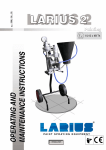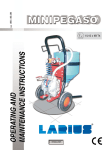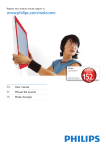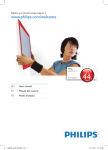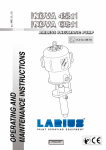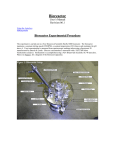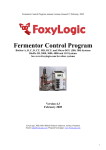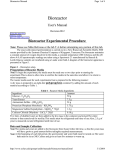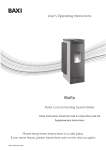Download Baxi Bioflo Specifications
Transcript
Supplementary Assembly Instructions for the UK Read the Assembly Instruction Booklet and these Supplementary Instructions carefully before Installation These instructions together with those supplied with the appliance cover the basic principles to ensure the satisfactory installation of the boiler. In all cases the installation must comply with current Building Regulations, Local Authority Byelaws and other specifications or regulations as they affect the installation of the boiler. It should be noted that the Building Regulations requirements can be met by adopting the relevant recommendations given in British Standards BS 8303, BS EN 15287-1:2007 as an alternative means to achieve an equivalent level of performance to that obtained following the guidance given in Approved Document J. Please note that it is a legal requirement under England and Wales Building Regulations that the installation of the boiler is either carried out under Local Authority Building Control approval or is installed by a Competent Person registered with a Government approved Competent Persons Scheme. HETAS Ltd operate such a scheme and a listing of their Registered Competent Persons can be found on their website at www.hetas.co.uk. Where ‘Building Regulations’ is quoted this refers to the building regulations for England and Wales. For Scotland and Northern Ireland use the appropriate Building Regulations Part F - (Scotland) and Building Regulations Part L - (Northern Ireland). Codes of Practice - refer to the most recent version BS 7671:2008 BS EN 1856 - 1+2 :2003 BS 8303 BS EN 15287 - 1:2007 Bioflo Pellet Central Heating System Boiler BS 8423: 2002 BS EN 12831:2003 BS EN 12828 BS 7593 BS EN 14336 BS EN 5546 BS EN 7074 BS EN 13384 - 1+2 :2002. Requirements for electrical installations. IEE Wiring Regulations. Requirements for metal chimneys - System chimney products. - 2:2004 metal liners and connecting flue pipes. Code of practice for installation of domestic heating and cooking appliances burning solid mineral fuels. Chimneys. Design, installation and commissioning of chimneys. Chimneys for non-room sealed heating appliances. Fireguards for fires and heating appliances for domestic use. Heating systems in buildings. Method for calculation of the design heat load Heating systems in buildings. Treatment of water in domestic hot water central heating systems Installation and commissioning of water based heating systems. Installation of hot water supplies for domestic purposes. Expansion vessels and ancillary equipment for sealed water systems. Chimneys - Thermal & fluid dynamic calculation methods - Chimneys serving one appliance. Health and Safety Precautions - Special care must be taken when installing the boiler such that the requirements of the Health and Safety at Work Act are met. Note: The addition of anything that may interfere with the normal operation of the appliance without express written permission from the manufacturer or his agent could invalidate the appliance warranty. This could also infringe the HETAS Regulations. Handling - Adequate facilities must be available for loading, unloading and site handling. Fire Cement - Some types of fire cement are caustic and should not be allowed to come into contact with skin. In case of contact wash immediately with plenty of water. Asbestos - This boiler contains no asbestos. If there is a possibility of disturbing any asbestos in the course of installation then please seek specialist guidance and use appropriate protective equipment. Metal Parts - When installing or servicing this boiler care should be taken to avoid the possibility of personal injury. © Baxi Heating UK Ltd 2010 Boiler Performance Total thermal output is 12 kW with 3.8 to 10.4 kW available for controlled space heating/domestic hot water production. The difference of 1.6 kW is accounted for by heat radiated directly into the room, unless the supplied shield is fitted in which case it will reduce this to 1.1 kW and increase the maximum output to10.9 kW. Flexible Connection Insulate Flue This must be taken in to account when designing the central heating system and in particular when siting the appliance. Preparatory Work and Safety Checks - IMPORTANT WARNING This boiler must not be installed into a chimney that serves any other heating appliance. 45° 0 - 30° 125mm Dia Adaptor There must not be an extractor or ceiling/paddle fan fitted in the same room as the boiler as this can effect the safe operation of the appliance. A Carbon monoxide sensor which complies with BS EN50291-1: 2001 must be fitted in the same room as the appliance and positioned as outlined in the Building Regulations Part J. Either mains or battery powered models may be used. 1m Max Consult the HETAS web site – www.hetas.co.uk for suitable models. 3m Max Further guidance on the installation of carbon monoxide alarms is available in BS EN 50292:2002 and from the manufacturers’ instructions. Provision of an alarm should not be regarded as a substitute for the correct installation and regular servicing. Chimney The chimney must be swept at least twice a year, one of which should be during the annual service, preferably at the beginning of the Heating season. . Flex Flue Masonry Chimney In order for the boiler to perform satisfactorily the chimney height must be sufficient to ensure an adequate draught of approximately -15 Pa so as to clear the products of combustion and prevent smoke emission into the room. NOTE: A chimney height of not less than 4.5 metres measured vertically from the outlet of the boiler to the top of the chimney should be satisfactory. The outlet from the chimney should be above the roof of the building in accordance with the provisions of Building Regulations Approved Document J. Connection to Chimney The appliance is supplied with a 125mm flue gas connector that allows connection to either a suitably lined masonry chimney or a prefabricated factory made insulated metal chimney in accordance with the instructions. It will be neccessary to fit an adaptor to the flue gas connector for chimney diameters greater than 125mm. Maximum diameter is 150mm. Because the boiler operates at high efficiencies, the temperature of the flue gases is at times lower than conventional solid fuel appliances. Although it is not classed as a condensing appliance, the low flue gas temperature results in condensation occurring within the flue. Any chimney flue system must therefore be able to withstand the effects of condensate and operate under wet conditions (designation letter W). In addition it should be soot fire resistant and able to withstand the corrosive effects of flue products generated by solid fuels Prefabricated (Designation G and 3 respectively). If installation is into an existing masonry chimney then it Metal Flue will require re-lining with a liner meeting the specification described above. Existing concrete or clay lined chimneys are NOT suitable for this boiler and must be lined as described above. All installations must be in accordance with Building Regulations Approved Document J. For suitable flue manufactures please refer to the HETAS web site as above. Any existing chimney must be clear of obstruction and have been swept clean immediately before installation of the lining system. If there is suitable liner already installed ensure any existing draught stabiliser is removed or sealed. If there is any doubt about the liner suitability it should be replaced. If there is no existing chimney then any new system must be to the designation described above and in accordance with Building Regulations Approved Document J. Under no circumstances should a flexible liner designed solely for use with gas fires be used with a solid fuel burning appliance. A single wall metal fluepipe is suitable for connecting the boiler to the chimney but is not suitable for use as the complete chimney. 2 © Baxi Heating UK Ltd 2010 Any bend in the chimney or connecting fluepipe should not exceed 45°. 90° bends should NOT be used. Combustible material should not be located where the heat dissipating through the walls of fireplaces or flues could ignite it. Therefore when installing the boiler in the presence of combustible materials due account must be taken of the guidance on the separation of combustible material given in Building Regulations Approved Document J. Clearances are also required for servicing around the appliance and to allow for radiation directly in front of the appliance see section 2.5 of the main Assembly Instructions. Adequate provision (e.g. easily accessible soot door or doors) must be provided for sweeping the chimney and connecting fluepipe. CO-emissions related to 13% O2 content at nominal / partial power 48/167 mg/mN3. Hearth The hearth should be able to accommodate the weight of the boiler, and its chimney if the chimney is not independently supported. The weight of the boiler is indicated in the brochure. The boiler should be installed on a non-combustible hearth of a size and construction that is in accordance with the provisions of the current Building Regulations Approved Document J. The clearance distances to combustible material beneath, surrounding or upon the hearth should comply with the guidance on the separation of combustible material given in Building Regulations Approved Document J. If the boiler is to be installed on a combustible floor surface, it must be covered with a non-combustible material at least 12mm thick, in accordance with Building Regulations Approved Document J to a distance of 30cm in front of the boiler and 15cm to each side measuring from the door of the combustion chamber. Combustion Air Supply This is an open flued appliance. The air supply can be provided either directly from outside via an air duct or from the room of installation. In order for the boiler to perform efficiently and safely there must be an adequate air supply into the room in which the boiler is installed to provide combustion air. The provision of air supply to the boiler must be in accordance with current Building Regulations Approved Document J. An opening window is NOT appropriate for this purpose. Combustion air ventilation requirements for the 12kW Baxi Bioflo: Air permeability Older properties >5 m3/(h.m2) Newer properties <5 m3/(h.m2) To outside 38.5 cm 66 cm Communicating walls 60 cm2 100 cm2 Air vents must be fitted lower than 450mm when in vertical walls. Alternatively the air supply may be provide via an air duct 75mm in diameter and up to 9m in length (reduced 1m in length for every 90° bend used) see section 2.3.4a of the Assembly Instructions. If an air vent duct is connected to the appliance for the provision of combustion air then a terminal guard /grill must be fitted to prevent vermin etc. from entering the appliance and or blocking the duct. A ball of 13 mm should not be able to pass through the grill. The installers should provide labels for the ducts and grilles with the following information. a) Air Inlet Duct Label. “This duct supplies air to a solid fuel appliance and its flueing system. It should not be blocked or restricted under any circumstances. For more information refer to the person responsible for the building; Name and contact details...............” b) Duct Grille Label. “The duct behind this grille supplies air to a solid fuel appliance and its flueing system. It should not be blocked or restricted under any circumstances. For more information refer to the person responsible for the building; Name and contact details ...............” © Baxi Heating UK Ltd 2010 3 Connection to the Central Heating System The appliance is intended for sealed systems only. The specific model imported is delivered with sealed system components inside. Sealed system components include: Expansion Vessel (12L) High Temp. Circulating Pump. Safety Valve and Pressure Gauge. A Filling Loop is not provided as standard (Multifit Filling Loop Kit 248221 is recommended). The central heating system must be in accordance with BS EN 14336:2004: Heating Systems in Buildings, Installation and commissioning of water based heating systems. BS EN 12828:2003; Heating Systems in Buildings, Design of water based heating systems. BS EN 12831:2003; Heating Systems in Buildings. Method of calculation of the design heat load. Electrical Connections The installation of any electrical services during the installation of this boiler and the associated heating system must be carried out by a registered competent electrician and in accordance with the requirements of the latest issue of BS 7671. • Power cable - 3 core to appliance. • 4 core cable to wiring centre from appliance ie. L1, N and E to wiring centre external controls. L2 switched live back to the appliance - see section 4.7 in Installation Instructioins. • Frost protection must be provided by a system frost stat. Commissioning and Handover Ensure all parts are fitted in accordance with the instructions. On completion of the installation allow a suitable period of time for any fire cement and mortar to dry out before lighting the boiler. Once the boiler is under fire check all seals for soundness and that the boiler and water system are operating correctly. Ensure that the flue is functioning correctly and that all products of combustion are vented safely to atmosphere via the chimney terminal. On completion of the installation and commissioning ensure that the operating instructions for the boiler are left with the customer. Ensure that the customer is familiar with the correct safe use of the appliance and emphasise that THE BOILER MUST BE OPERATED ONLY WITH THE RECOMMENDED FUEL. BA X I A Tr a din g D i v i s i on of B a x i Heat i ng U K Lt d ( 3879156) Brooks House, Coventry Road, Warwick. CV34 4LL After Sales Service & Technical Enquiries 0844 871 1568 Website www.baxi.co.uk e&oe © Baxi Heating UK Ltd 2010 All descriptions and illustrations provided in this leaflet have been carefully prepared but we reserve the right to make changes and improvements in our products which may affect the accuracy of the information contained in this leaflet. All goods are sold subject to our standard Conditions of Sale which are available on request. Issue 720574301a (10/10) Supplementary Operating Instructions for the UK Read the Operating Manual and these Supplementary Instructions carefully before using the boiler USER OPERATING INSTRUCTIONS Please read the important notices overleaf before referring to the Operating Manual book for detailed operating instructions. RECOMMENDED FUELS The boiler is designed to burn only specialised compressed wood pellets which are detailed in the main instruction book. These pellets must meet the DINplus quality standard. The recommended suppliers for the pellets is: For a local distribution outlet please telephone on; Tel: +44 (0)28 6641 1001 For an interactive map of local distributors please view the following website; Web site: http://www.brites.eu/ UNDER NO CIRCUMSTANCES SHOULD YOU ATTEMPT TO BURN ANY OTHER TYPE OF FUEL INCLUDING PELLETS THAT DO NOT MEET THE DINPLUS STANDARD. SERVICE AND MAINTENANCE This appliance should only be installed, serviced and maintained by HETAS Ltd trained operatives. Contact Heateam for suitable trained operatives on 0844 871 1568. Bioflo Biomass Pellet Central Heating System Boiler WARNING NOTE Properly installed, operated and maintained this boiler will not emit fumes into the dwelling. Occasional fumes from de-ashing and re-fuelling may occur. However, persistent fume emission is potentially dangerous and must not be tolerated. If fume emissions persist, then the following immediate action should be taken:a) b) c) d) Open the doors and windows to ventilate room Let the fire go out, remove and safely dispose of fuel from the appliance Check flue or chimney blockage clean if required Do not attempt to relight the fire until the cause of fume emission has been identified and corrected. If necessary seek expert advice. The most common cause of fume emission is flueway or chimney blockage. For your own safety these must be kept clean at all times. General Before lighting the boiler check with the installer that the installation work and commissioning checks have been carried out correctly and that the chimney has been swept clean, is sound and free from any obstructions. As part of the boilers’ commissioning and handover the installer should have shown you how to operate the boiler correctly. Do not light the boiler if there is a possibility that any part of the heating system may be frozen. © Baxi Heating UK Ltd 2010 Important Notes Use of Fireguard When using the boiler in situations where children, aged and/or infirm persons are present a fireguard must be used to prevent accidental contact with the boiler. The fireguard should be manufactured in accordance with BS 8423:2002. The minimum clearance distances quoted in section 2.5 of the operating manual must be adhered to - NOTE: there is a minimum distance of 50mm for moveable combustible objects such as furniture and clothing. Chimney Cleaning The chimney should be swept at least twice a year, one of which should be during the annual service, preferably at the beginning of the heating season. It is important that the flue connection and chimney are swept prior to lighting up after a prolonged shutdown period. In situations where it is not possible to sweep through the boiler the installer will have provided alternative means, such as a soot door. After sweeping the chimney the boiler flue outlet and the flue pipe connecting the boiler to the chimney must be cleaned with a flue brush. A database of approved chimney sweeps is available from; HETAS Ltd Orchard Business Centre Stoke Orchard Cheltenham Gloucestershire GL52 7RZ Via email at; [email protected] Via telephone on; 0845 601 4406 Or via the web; http://www.hetas.co.uk/pdfs/NACS_index.pdf Period of Prolonged Non-Use If the boiler is to be left unused for a prolonged period of time ie. during the summer months, then it should be given a thorough clean to remove ash and unburned fuel residues. Empty the hopper of unburned fuel. To enable a good flow of air through the appliance to reduce condensation and to avoid door seals becoming stuck and subsequently damaged, leave the filling hatch and combustion chamber doors slightly ajar. These actions will reduce the possibility of unnecessary damage and corrosion. The chimney should be swept before relighting - see above chimney cleaning. Extractor Fan There must not be an extractor or ceiling/paddle fan fitted in the same room as the boiler as this can cause the boiler to emit smoke and fumes into the room. Aerosol Sprays Do not use an aerosol spray on or near the boiler when it is alight. Use of Operating Tools Always use the operating tools provided when handling parts likely to be hot. Chimney Fires If the chimney is thoroughly and regularly swept, chimney fires should not occur. However, in the unlikely event that a chimney fire does occur, turn off the boiler immediately and isolate the mains electricity supply if it safe to do so. If the fire does not go out, the fire brigade should be called immediately. Retire to a safe distance from the fire. Do not re-enter the property until it is safe to do so. Do not relight the boiler until the chimney and flueways have been cleaned and examined by a competent person. Permanent Air Vent The boiler requires a permanent and adequate air supply in order for it to operate safely and efficiently. The installer will have fitted either a permanent air supply vent into the room where the appliance is fitted as detailed in the Part J of the current Building Regulations or connected a permanent 70 diameter tube to the outside of the property. In either case these should not be shut off or sealed or tampered with in any way. BA X I A Tr a din g D i v i s i on of B a x i Heat i ng U K Lt d ( 3879156) Brooks House, Coventry Road, Warwick. CV34 4LL After Sales Service & Technical Enquiries 0844 871 1568 Website www.baxi.co.uk e&oe © Baxi Heating UK Ltd 2010 All descriptions and illustrations provided in this leaflet have been carefully prepared but we reserve the right to make changes and improvements in our products which may affect the accuracy of the information contained in this leaflet. All goods are sold subject to our standard Conditions of Sale which are available on request. Issue 720574201 (9/10)






